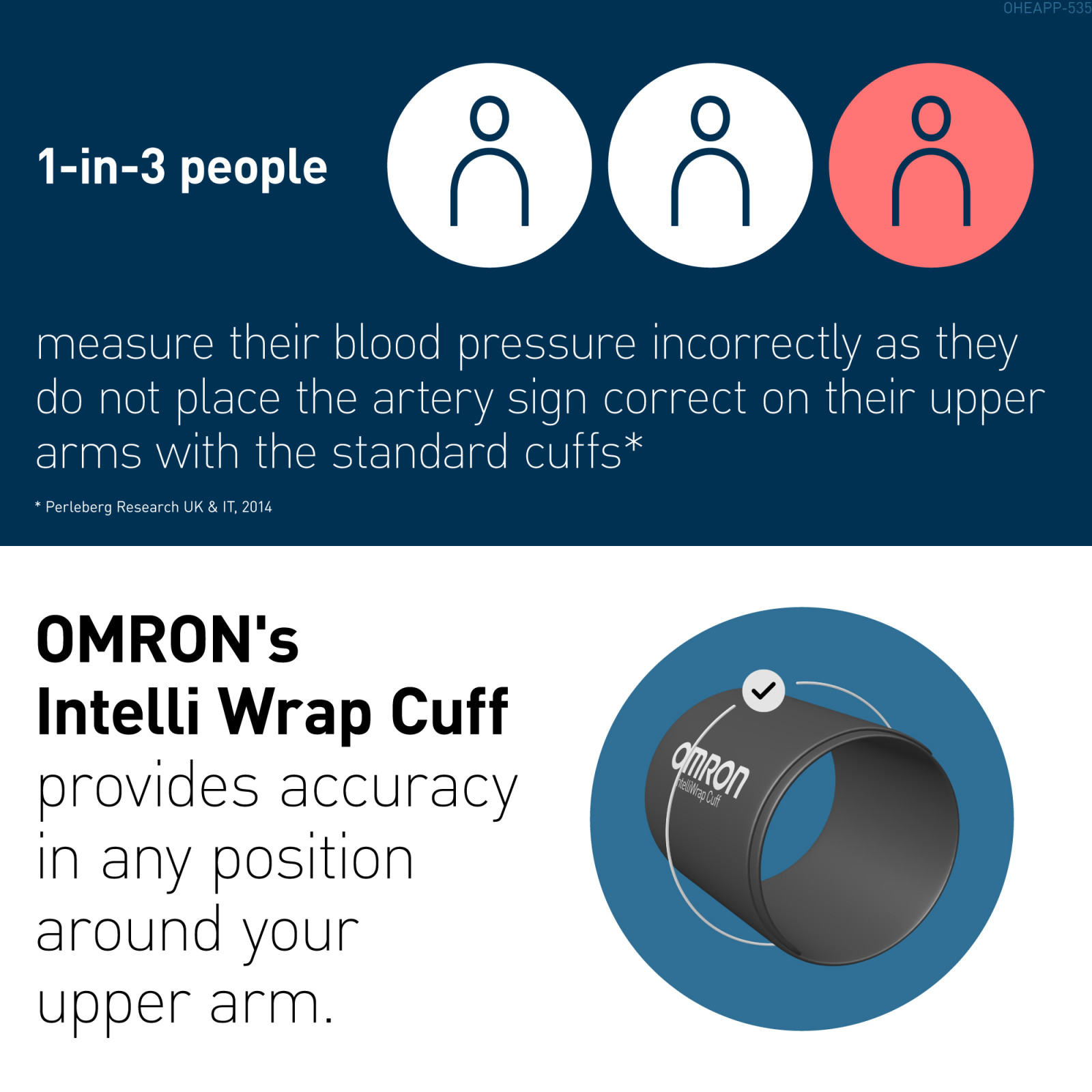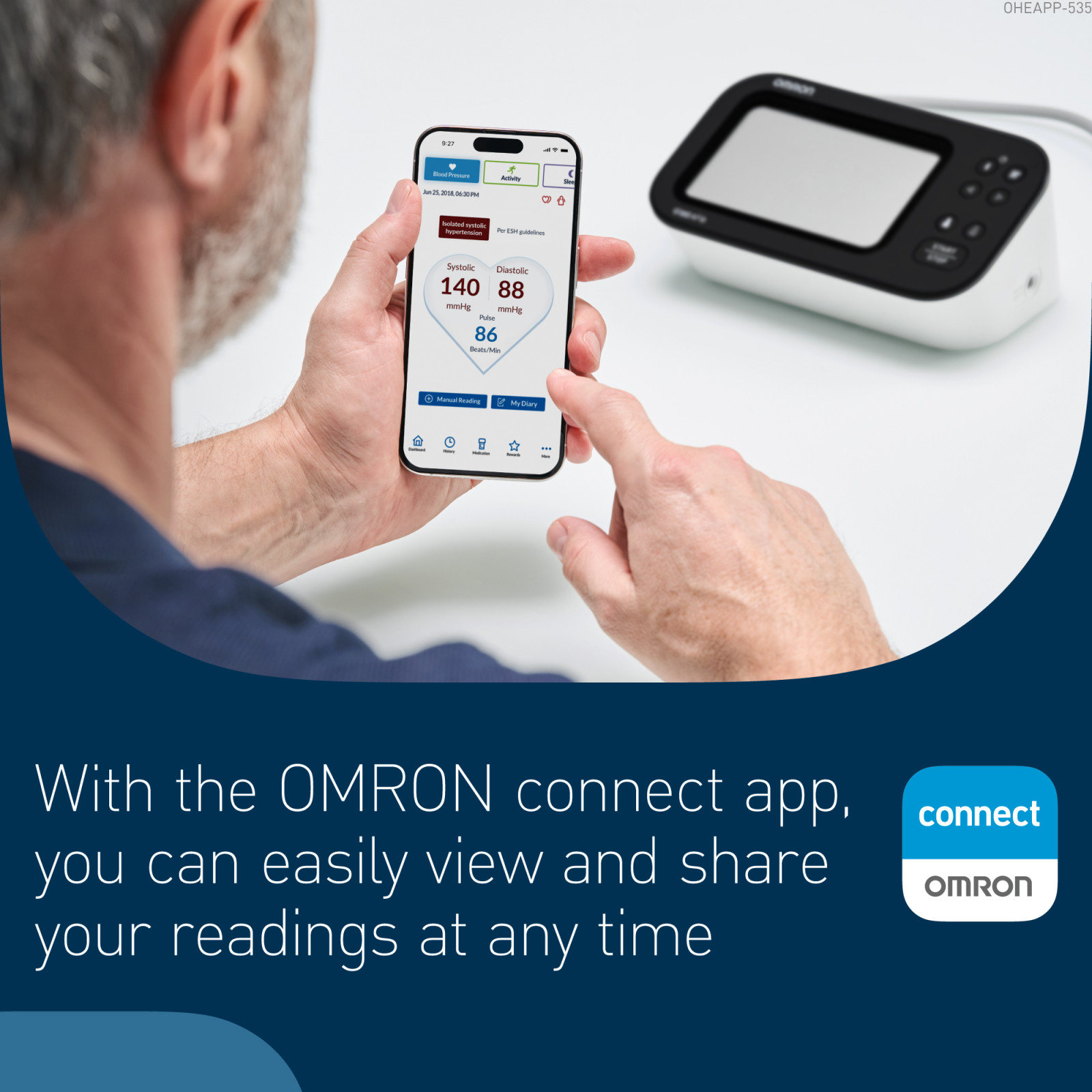







M7 Intelli IT AFib
Blood Pressure Monitors
5 years of warranty
AFib detection in 1 single measurement
Possible AFib detection with every measurement
Intelli wrap cuff (22-42 cm)
OMRON connect
2 users x 100 memories + guest mode
Irregular heartbeat detection
High blood pressure indicator
Clinically validated, also in patients with type II diabetes and pregancy with and without pre-eclampsia
Transform your home blood pressure check into a powerful defence against stroke with M7 intelli IT AFib, powered by the clinically validated Intellisense AFib technology by OMRON.
Thanks to the revolutionary Intellisense AFib technology, now routine blood pressure checks automatically screen for Atrial Fibrillation, a heart rhythm disorder that is often undiagnosed but significantly increases stroke risk in people with hypertension.
With a touch of a button, automatically screen for AFib every time you measure your blood pressure. Maximize the benefits of regular monitoring, help prevent more serious complications and have a more comprehensive overview of your heart health, reducing the stress of uncertainty.
Automatically update your latest results to your smartphone by Bluetooth and have your blood pressure readings at your fingertips through the OMRON connect app or you can just ask Alexa to let you know your latest readings without even picking up your phone.
Take the hassle out of cuff placement on your upper arm thanks to OMRON’s unique Intelli Wrap Cuff – giving accurate blood pressure measurements in any position around the upper arm.
1 x OMRON M7 Intelli IT AFib blood pressure monitor, 22-42 cm Intelli Wrap arm cuff, 4 x AA batteries, instruction manual, storage case, blood pressure pass.
- Weight of Device (kg)
- 0.44
- Cuff Type
- Intelli Wrap Cuff 22–42 cm
- Cuff Wrap Guide
- Yes
- Memory management
- 2 users x 100 readings plus guest mode
- Irregular Heartbeat Detection
- Yes
- Body Movement Detection
- Yes
- Validation
- Clinical Validation, Diabetic Validation, Pregnancy Validation
- AFib detection
- Yes
- Easy High Blood Pressure Indicator
- Yes
- Advanced Positioning Sensor
- Yes
- Intellisense
- Yes
- Storage Case Included
- Yes
- Averaging Function
- Yes
- Connected
- Yes
- Compatible Mobile App
- OMRON connect app
- Item Dimensions (mm)
- 191 x 85 x 117
Early detection is key in stroke prevention
How to Use
Clinically validated for accuracy, our revolutionary Intellisense AFib technology turns your routine blood pressure checks at home into a powerful defense against stroke. The Intelli Wrap Cuff ensures accurate results, no matter how it is worn. It is easy to use, providing a sure fit with a pre-shaped design that works in any position around the upper arm.




Maximize the benefits of regular monitoring
Early detection, better outcomes
Spotting AFib signs early from home can prevent more serious complications with timely and effective interventions.
Know when to seek help
Home monitoring delivers a more comprehensive overview of your heart health, reducing the stress of uncertainty.
Dual function
With a touch of a button, automatically screen for AFib every time you measure your blood pressure.
No extra step needed
Eliminate the need for multiple health gadgets enabling a single-step at-home screening.
External References:
Moody GB, Mark RG. The impact of the MIT-BIH Arrhythmia Database. IEEE Eng in Med and Biol 20(3):45-50 (May-June 2001). (PMID: 11446209) Contains information from “MIT-BIH Arrhythmia Database” which is made available under the ODC Attribution License. doi:10.13026/C2F305
Moody GB, Mark RG. A new method for detecting atrial fibrillation using R-R intervals. Computers in Cardiology. 10:227-230 (1983). Contains information from “MIT-BIH Atrial Fibrillation Database” which is made available under the ODC Attribution License. doi:10.13026/C2MW2D
Clifford GD, Liu C, Moody B, Li-wei HL, Silva I, Li Q, Johnson AE, Mark RG. AF classification from a short single lead ECG recording: The PhysioNet/computing in cardiology challenge 2017. In 2017 Computing in Cardiology (CinC) 2017 Sep 24 (pp. 1-4). IEEE. doi:10.22489/CinC.2017.065-469 Contains information from “AF Classification from a Short Single Lead ECG Recording: The PhysioNet/Computing in Cardiology Challenge 2017” which is made available under the ODC Attribution License. https://physionet.org/content/challenge-2017/1.0.0/training/#files-panel https://opendatacommons.org/licenses/by/1-0/
Goldberger, A., Amaral, L., Glass, L., Hausdorff, J., Ivanov, P. C., Mark, R., ... & Stanley, H. E. (2000). PhysioBank, PhysioToolkit, and PhysioNet: Components of a new research resource for complex physiologic signals. Circulation [Online]. 101 (23), pp. e215–e220.